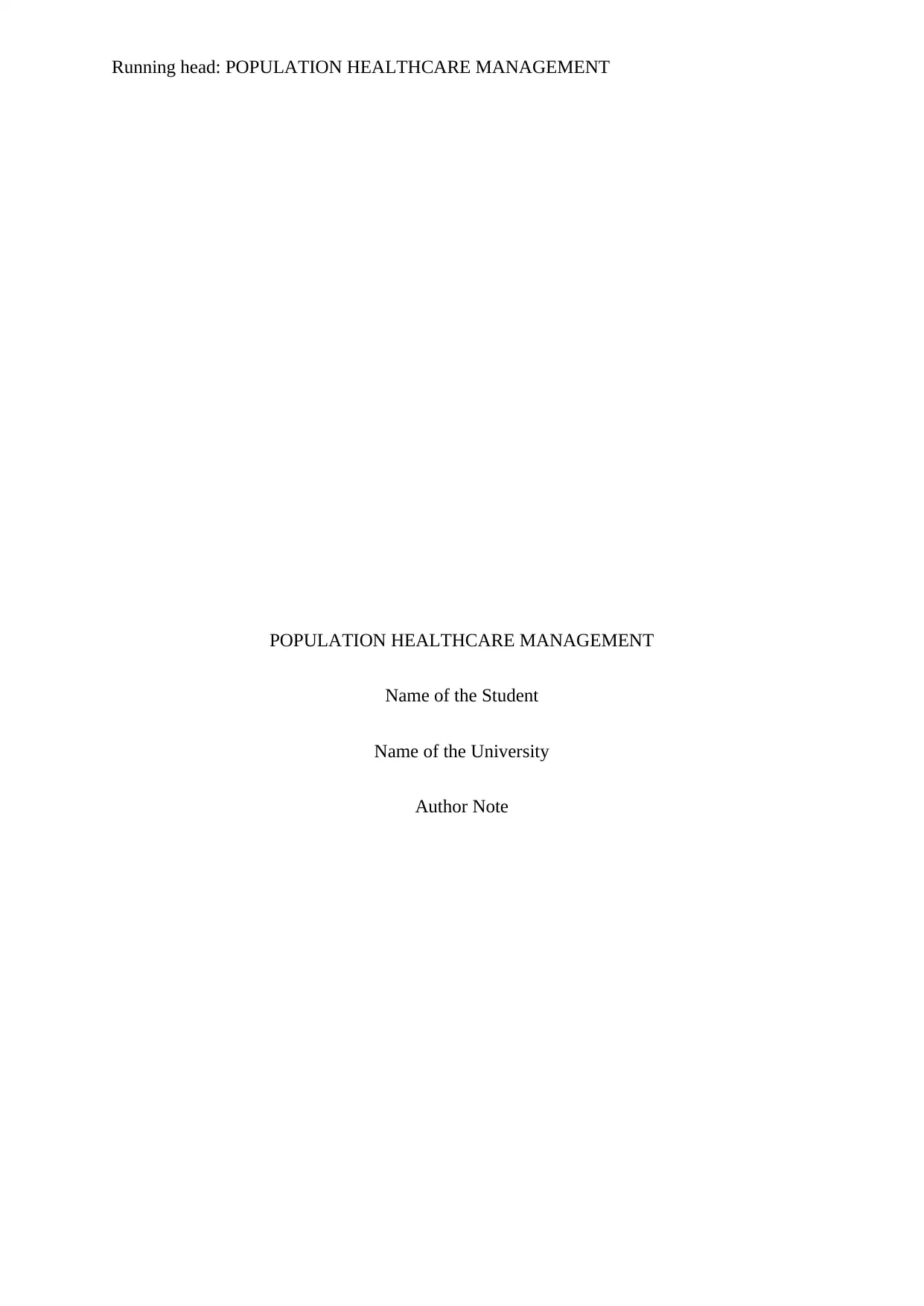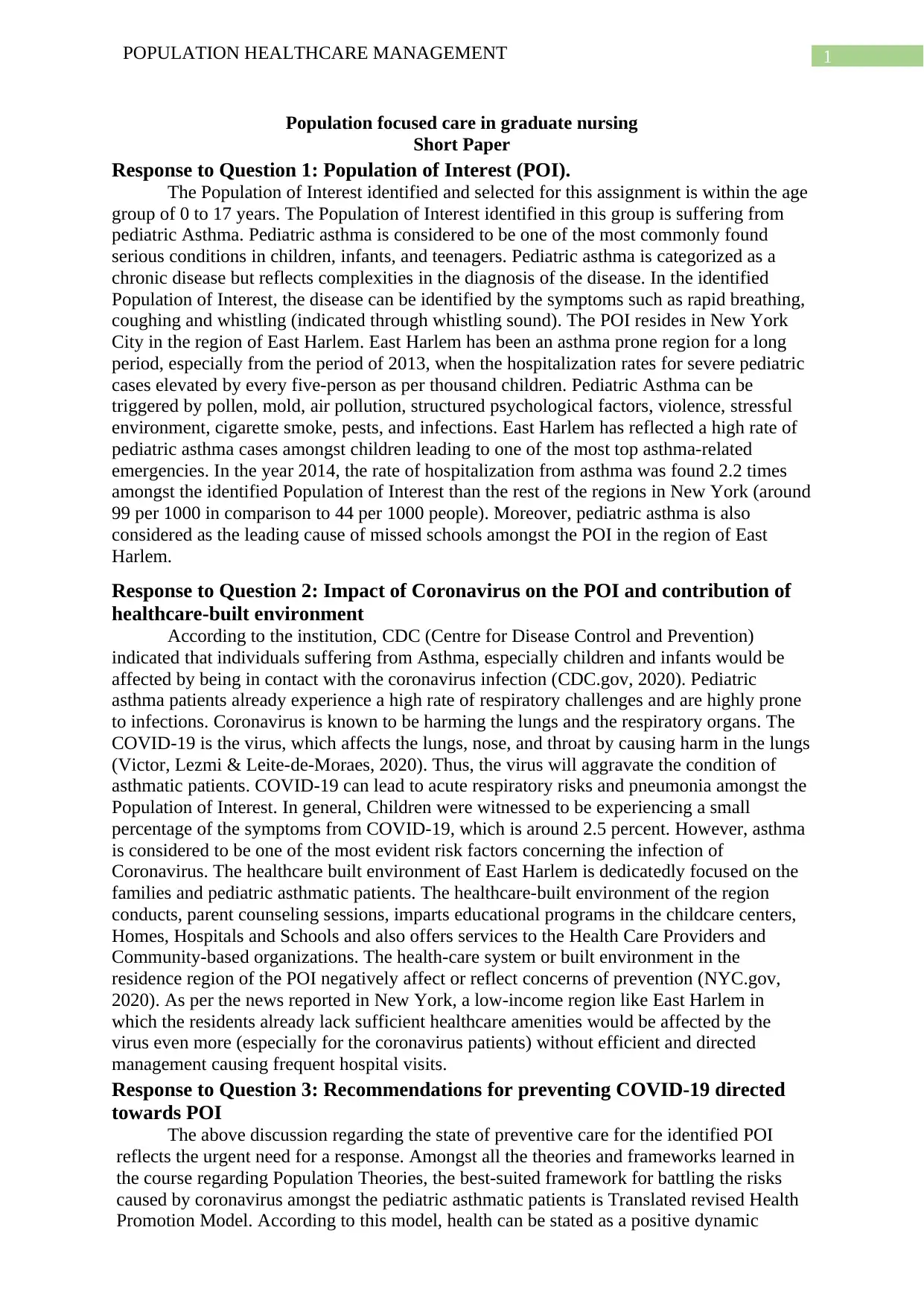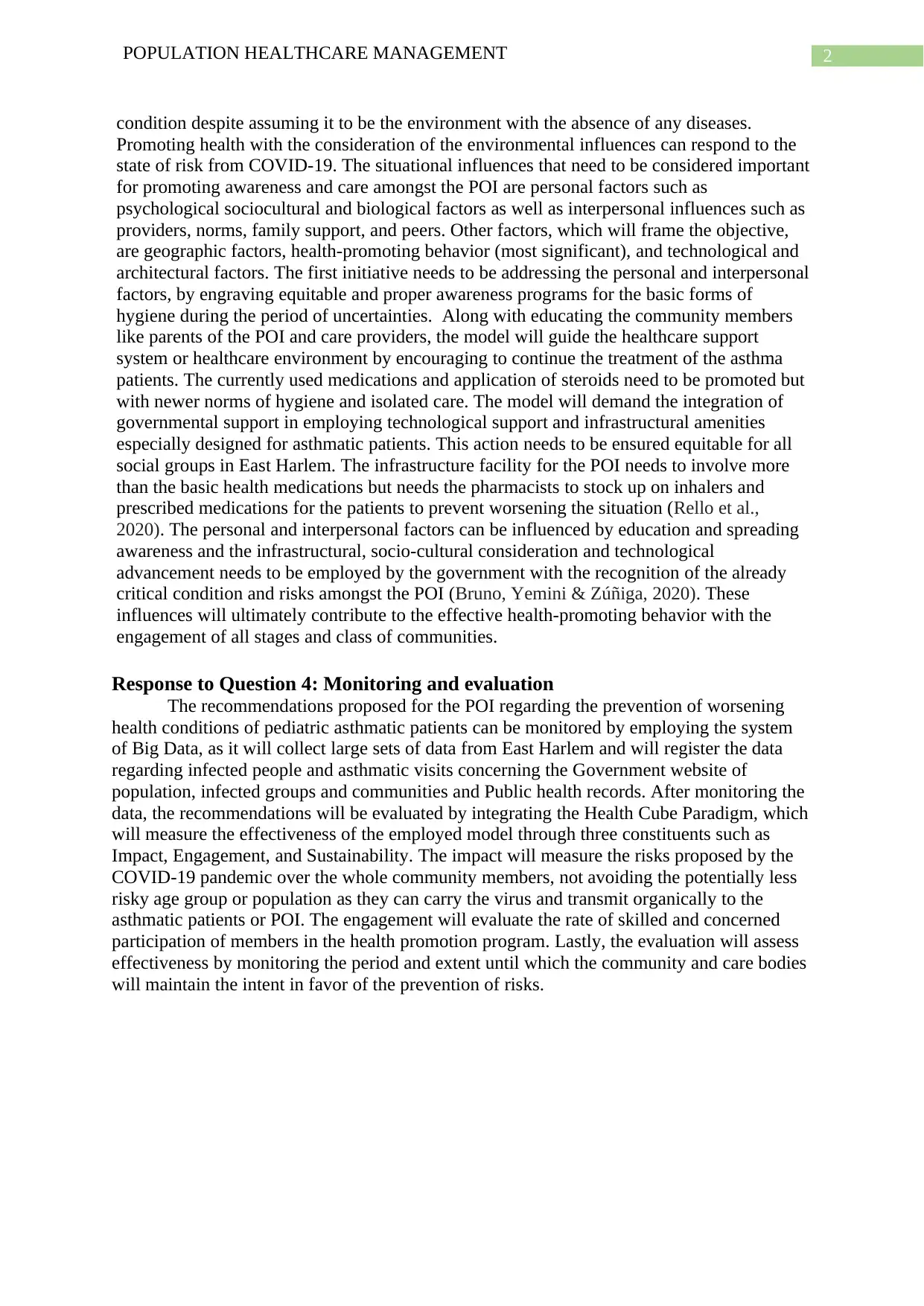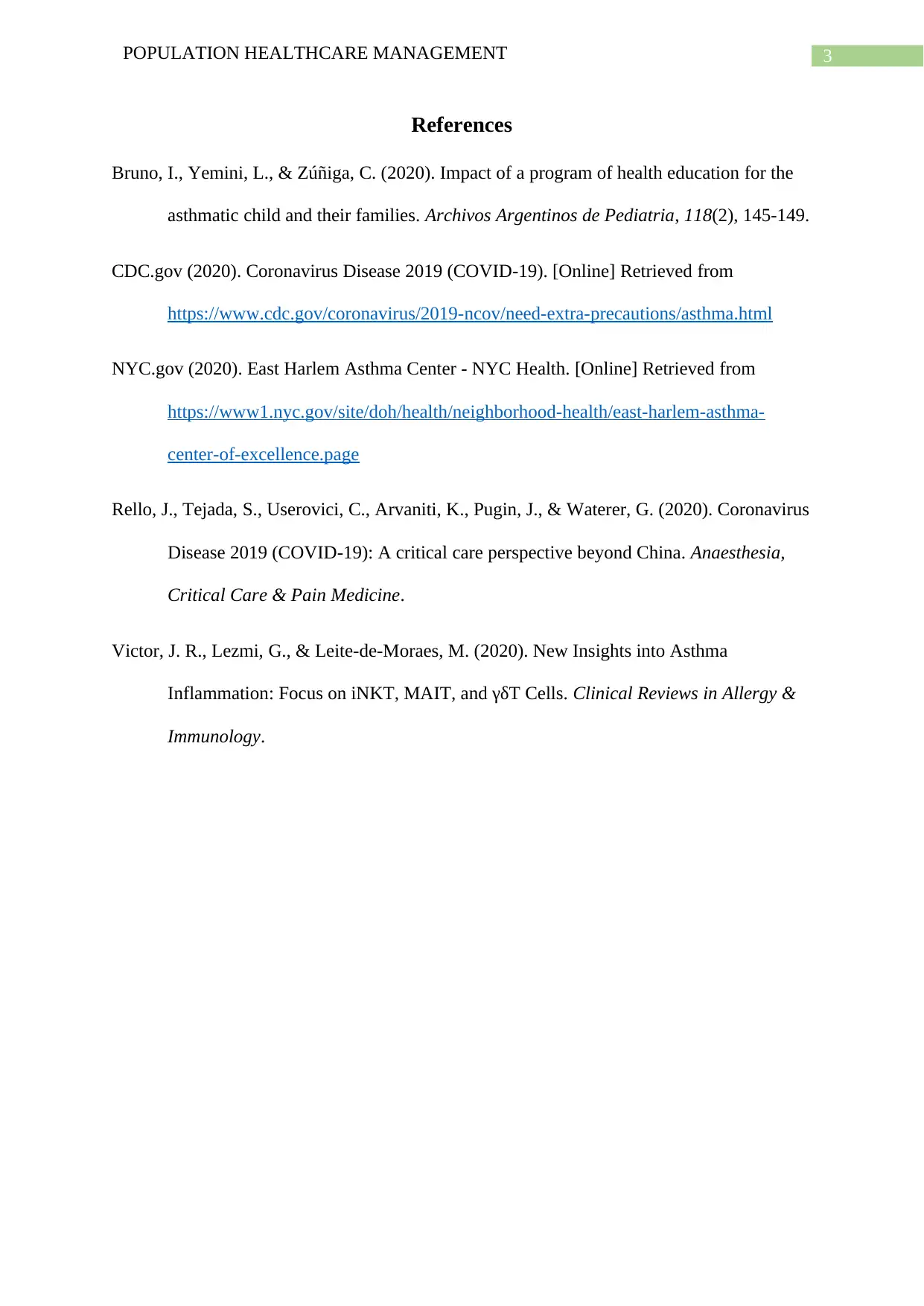Population Health: Asthma and COVID-19 in East Harlem, NYC
VerifiedAdded on 2022/09/26
|4
|1457
|24
Report
AI Summary
This report analyzes the impact of COVID-19 on pediatric asthma in East Harlem, New York City, focusing on children aged 0-17. It examines the heightened risks faced by asthmatic children due to the virus, considering the challenges of the healthcare-built environment in this low-income region. The study proposes using the Translated Revised Health Promotion Model to develop awareness programs, encourage treatment adherence, and integrate governmental support for technological and infrastructural improvements. The recommendations include hygiene education, continued asthma treatment, and equitable resource allocation. The report suggests monitoring these recommendations using Big Data to gather information from public health records and evaluating their effectiveness using the Health Cube Paradigm, which considers impact, engagement, and sustainability. The goal is to improve health outcomes and prevent the worsening of health conditions among pediatric asthma patients during the pandemic.

Running head: POPULATION HEALTHCARE MANAGEMENT
POPULATION HEALTHCARE MANAGEMENT
Name of the Student
Name of the University
Author Note
POPULATION HEALTHCARE MANAGEMENT
Name of the Student
Name of the University
Author Note
Paraphrase This Document
Need a fresh take? Get an instant paraphrase of this document with our AI Paraphraser

1POPULATION HEALTHCARE MANAGEMENT
Population focused care in graduate nursing
Short Paper
Response to Question 1: Population of Interest (POI).
The Population of Interest identified and selected for this assignment is within the age
group of 0 to 17 years. The Population of Interest identified in this group is suffering from
pediatric Asthma. Pediatric asthma is considered to be one of the most commonly found
serious conditions in children, infants, and teenagers. Pediatric asthma is categorized as a
chronic disease but reflects complexities in the diagnosis of the disease. In the identified
Population of Interest, the disease can be identified by the symptoms such as rapid breathing,
coughing and whistling (indicated through whistling sound). The POI resides in New York
City in the region of East Harlem. East Harlem has been an asthma prone region for a long
period, especially from the period of 2013, when the hospitalization rates for severe pediatric
cases elevated by every five-person as per thousand children. Pediatric Asthma can be
triggered by pollen, mold, air pollution, structured psychological factors, violence, stressful
environment, cigarette smoke, pests, and infections. East Harlem has reflected a high rate of
pediatric asthma cases amongst children leading to one of the most top asthma-related
emergencies. In the year 2014, the rate of hospitalization from asthma was found 2.2 times
amongst the identified Population of Interest than the rest of the regions in New York (around
99 per 1000 in comparison to 44 per 1000 people). Moreover, pediatric asthma is also
considered as the leading cause of missed schools amongst the POI in the region of East
Harlem.
Response to Question 2: Impact of Coronavirus on the POI and contribution of
healthcare-built environment
According to the institution, CDC (Centre for Disease Control and Prevention)
indicated that individuals suffering from Asthma, especially children and infants would be
affected by being in contact with the coronavirus infection (CDC.gov, 2020). Pediatric
asthma patients already experience a high rate of respiratory challenges and are highly prone
to infections. Coronavirus is known to be harming the lungs and the respiratory organs. The
COVID-19 is the virus, which affects the lungs, nose, and throat by causing harm in the lungs
(Victor, Lezmi & Leite-de-Moraes, 2020). Thus, the virus will aggravate the condition of
asthmatic patients. COVID-19 can lead to acute respiratory risks and pneumonia amongst the
Population of Interest. In general, Children were witnessed to be experiencing a small
percentage of the symptoms from COVID-19, which is around 2.5 percent. However, asthma
is considered to be one of the most evident risk factors concerning the infection of
Coronavirus. The healthcare built environment of East Harlem is dedicatedly focused on the
families and pediatric asthmatic patients. The healthcare-built environment of the region
conducts, parent counseling sessions, imparts educational programs in the childcare centers,
Homes, Hospitals and Schools and also offers services to the Health Care Providers and
Community-based organizations. The health-care system or built environment in the
residence region of the POI negatively affect or reflect concerns of prevention (NYC.gov,
2020). As per the news reported in New York, a low-income region like East Harlem in
which the residents already lack sufficient healthcare amenities would be affected by the
virus even more (especially for the coronavirus patients) without efficient and directed
management causing frequent hospital visits.
Response to Question 3: Recommendations for preventing COVID-19 directed
towards POI
The above discussion regarding the state of preventive care for the identified POI
reflects the urgent need for a response. Amongst all the theories and frameworks learned in
the course regarding Population Theories, the best-suited framework for battling the risks
caused by coronavirus amongst the pediatric asthmatic patients is Translated revised Health
Promotion Model. According to this model, health can be stated as a positive dynamic
Population focused care in graduate nursing
Short Paper
Response to Question 1: Population of Interest (POI).
The Population of Interest identified and selected for this assignment is within the age
group of 0 to 17 years. The Population of Interest identified in this group is suffering from
pediatric Asthma. Pediatric asthma is considered to be one of the most commonly found
serious conditions in children, infants, and teenagers. Pediatric asthma is categorized as a
chronic disease but reflects complexities in the diagnosis of the disease. In the identified
Population of Interest, the disease can be identified by the symptoms such as rapid breathing,
coughing and whistling (indicated through whistling sound). The POI resides in New York
City in the region of East Harlem. East Harlem has been an asthma prone region for a long
period, especially from the period of 2013, when the hospitalization rates for severe pediatric
cases elevated by every five-person as per thousand children. Pediatric Asthma can be
triggered by pollen, mold, air pollution, structured psychological factors, violence, stressful
environment, cigarette smoke, pests, and infections. East Harlem has reflected a high rate of
pediatric asthma cases amongst children leading to one of the most top asthma-related
emergencies. In the year 2014, the rate of hospitalization from asthma was found 2.2 times
amongst the identified Population of Interest than the rest of the regions in New York (around
99 per 1000 in comparison to 44 per 1000 people). Moreover, pediatric asthma is also
considered as the leading cause of missed schools amongst the POI in the region of East
Harlem.
Response to Question 2: Impact of Coronavirus on the POI and contribution of
healthcare-built environment
According to the institution, CDC (Centre for Disease Control and Prevention)
indicated that individuals suffering from Asthma, especially children and infants would be
affected by being in contact with the coronavirus infection (CDC.gov, 2020). Pediatric
asthma patients already experience a high rate of respiratory challenges and are highly prone
to infections. Coronavirus is known to be harming the lungs and the respiratory organs. The
COVID-19 is the virus, which affects the lungs, nose, and throat by causing harm in the lungs
(Victor, Lezmi & Leite-de-Moraes, 2020). Thus, the virus will aggravate the condition of
asthmatic patients. COVID-19 can lead to acute respiratory risks and pneumonia amongst the
Population of Interest. In general, Children were witnessed to be experiencing a small
percentage of the symptoms from COVID-19, which is around 2.5 percent. However, asthma
is considered to be one of the most evident risk factors concerning the infection of
Coronavirus. The healthcare built environment of East Harlem is dedicatedly focused on the
families and pediatric asthmatic patients. The healthcare-built environment of the region
conducts, parent counseling sessions, imparts educational programs in the childcare centers,
Homes, Hospitals and Schools and also offers services to the Health Care Providers and
Community-based organizations. The health-care system or built environment in the
residence region of the POI negatively affect or reflect concerns of prevention (NYC.gov,
2020). As per the news reported in New York, a low-income region like East Harlem in
which the residents already lack sufficient healthcare amenities would be affected by the
virus even more (especially for the coronavirus patients) without efficient and directed
management causing frequent hospital visits.
Response to Question 3: Recommendations for preventing COVID-19 directed
towards POI
The above discussion regarding the state of preventive care for the identified POI
reflects the urgent need for a response. Amongst all the theories and frameworks learned in
the course regarding Population Theories, the best-suited framework for battling the risks
caused by coronavirus amongst the pediatric asthmatic patients is Translated revised Health
Promotion Model. According to this model, health can be stated as a positive dynamic

2POPULATION HEALTHCARE MANAGEMENT
condition despite assuming it to be the environment with the absence of any diseases.
Promoting health with the consideration of the environmental influences can respond to the
state of risk from COVID-19. The situational influences that need to be considered important
for promoting awareness and care amongst the POI are personal factors such as
psychological sociocultural and biological factors as well as interpersonal influences such as
providers, norms, family support, and peers. Other factors, which will frame the objective,
are geographic factors, health-promoting behavior (most significant), and technological and
architectural factors. The first initiative needs to be addressing the personal and interpersonal
factors, by engraving equitable and proper awareness programs for the basic forms of
hygiene during the period of uncertainties. Along with educating the community members
like parents of the POI and care providers, the model will guide the healthcare support
system or healthcare environment by encouraging to continue the treatment of the asthma
patients. The currently used medications and application of steroids need to be promoted but
with newer norms of hygiene and isolated care. The model will demand the integration of
governmental support in employing technological support and infrastructural amenities
especially designed for asthmatic patients. This action needs to be ensured equitable for all
social groups in East Harlem. The infrastructure facility for the POI needs to involve more
than the basic health medications but needs the pharmacists to stock up on inhalers and
prescribed medications for the patients to prevent worsening the situation (Rello et al.,
2020). The personal and interpersonal factors can be influenced by education and spreading
awareness and the infrastructural, socio-cultural consideration and technological
advancement needs to be employed by the government with the recognition of the already
critical condition and risks amongst the POI (Bruno, Yemini & Zúñiga, 2020). These
influences will ultimately contribute to the effective health-promoting behavior with the
engagement of all stages and class of communities.
Response to Question 4: Monitoring and evaluation
The recommendations proposed for the POI regarding the prevention of worsening
health conditions of pediatric asthmatic patients can be monitored by employing the system
of Big Data, as it will collect large sets of data from East Harlem and will register the data
regarding infected people and asthmatic visits concerning the Government website of
population, infected groups and communities and Public health records. After monitoring the
data, the recommendations will be evaluated by integrating the Health Cube Paradigm, which
will measure the effectiveness of the employed model through three constituents such as
Impact, Engagement, and Sustainability. The impact will measure the risks proposed by the
COVID-19 pandemic over the whole community members, not avoiding the potentially less
risky age group or population as they can carry the virus and transmit organically to the
asthmatic patients or POI. The engagement will evaluate the rate of skilled and concerned
participation of members in the health promotion program. Lastly, the evaluation will assess
effectiveness by monitoring the period and extent until which the community and care bodies
will maintain the intent in favor of the prevention of risks.
condition despite assuming it to be the environment with the absence of any diseases.
Promoting health with the consideration of the environmental influences can respond to the
state of risk from COVID-19. The situational influences that need to be considered important
for promoting awareness and care amongst the POI are personal factors such as
psychological sociocultural and biological factors as well as interpersonal influences such as
providers, norms, family support, and peers. Other factors, which will frame the objective,
are geographic factors, health-promoting behavior (most significant), and technological and
architectural factors. The first initiative needs to be addressing the personal and interpersonal
factors, by engraving equitable and proper awareness programs for the basic forms of
hygiene during the period of uncertainties. Along with educating the community members
like parents of the POI and care providers, the model will guide the healthcare support
system or healthcare environment by encouraging to continue the treatment of the asthma
patients. The currently used medications and application of steroids need to be promoted but
with newer norms of hygiene and isolated care. The model will demand the integration of
governmental support in employing technological support and infrastructural amenities
especially designed for asthmatic patients. This action needs to be ensured equitable for all
social groups in East Harlem. The infrastructure facility for the POI needs to involve more
than the basic health medications but needs the pharmacists to stock up on inhalers and
prescribed medications for the patients to prevent worsening the situation (Rello et al.,
2020). The personal and interpersonal factors can be influenced by education and spreading
awareness and the infrastructural, socio-cultural consideration and technological
advancement needs to be employed by the government with the recognition of the already
critical condition and risks amongst the POI (Bruno, Yemini & Zúñiga, 2020). These
influences will ultimately contribute to the effective health-promoting behavior with the
engagement of all stages and class of communities.
Response to Question 4: Monitoring and evaluation
The recommendations proposed for the POI regarding the prevention of worsening
health conditions of pediatric asthmatic patients can be monitored by employing the system
of Big Data, as it will collect large sets of data from East Harlem and will register the data
regarding infected people and asthmatic visits concerning the Government website of
population, infected groups and communities and Public health records. After monitoring the
data, the recommendations will be evaluated by integrating the Health Cube Paradigm, which
will measure the effectiveness of the employed model through three constituents such as
Impact, Engagement, and Sustainability. The impact will measure the risks proposed by the
COVID-19 pandemic over the whole community members, not avoiding the potentially less
risky age group or population as they can carry the virus and transmit organically to the
asthmatic patients or POI. The engagement will evaluate the rate of skilled and concerned
participation of members in the health promotion program. Lastly, the evaluation will assess
effectiveness by monitoring the period and extent until which the community and care bodies
will maintain the intent in favor of the prevention of risks.
⊘ This is a preview!⊘
Do you want full access?
Subscribe today to unlock all pages.

Trusted by 1+ million students worldwide

3POPULATION HEALTHCARE MANAGEMENT
References
Bruno, I., Yemini, L., & Zúñiga, C. (2020). Impact of a program of health education for the
asthmatic child and their families. Archivos Argentinos de Pediatria, 118(2), 145-149.
CDC.gov (2020). Coronavirus Disease 2019 (COVID-19). [Online] Retrieved from
https://www.cdc.gov/coronavirus/2019-ncov/need-extra-precautions/asthma.html
NYC.gov (2020). East Harlem Asthma Center - NYC Health. [Online] Retrieved from
https://www1.nyc.gov/site/doh/health/neighborhood-health/east-harlem-asthma-
center-of-excellence.page
Rello, J., Tejada, S., Userovici, C., Arvaniti, K., Pugin, J., & Waterer, G. (2020). Coronavirus
Disease 2019 (COVID-19): A critical care perspective beyond China. Anaesthesia,
Critical Care & Pain Medicine.
Victor, J. R., Lezmi, G., & Leite-de-Moraes, M. (2020). New Insights into Asthma
Inflammation: Focus on iNKT, MAIT, and γδT Cells. Clinical Reviews in Allergy &
Immunology.
References
Bruno, I., Yemini, L., & Zúñiga, C. (2020). Impact of a program of health education for the
asthmatic child and their families. Archivos Argentinos de Pediatria, 118(2), 145-149.
CDC.gov (2020). Coronavirus Disease 2019 (COVID-19). [Online] Retrieved from
https://www.cdc.gov/coronavirus/2019-ncov/need-extra-precautions/asthma.html
NYC.gov (2020). East Harlem Asthma Center - NYC Health. [Online] Retrieved from
https://www1.nyc.gov/site/doh/health/neighborhood-health/east-harlem-asthma-
center-of-excellence.page
Rello, J., Tejada, S., Userovici, C., Arvaniti, K., Pugin, J., & Waterer, G. (2020). Coronavirus
Disease 2019 (COVID-19): A critical care perspective beyond China. Anaesthesia,
Critical Care & Pain Medicine.
Victor, J. R., Lezmi, G., & Leite-de-Moraes, M. (2020). New Insights into Asthma
Inflammation: Focus on iNKT, MAIT, and γδT Cells. Clinical Reviews in Allergy &
Immunology.
1 out of 4
Your All-in-One AI-Powered Toolkit for Academic Success.
+13062052269
info@desklib.com
Available 24*7 on WhatsApp / Email
![[object Object]](/_next/static/media/star-bottom.7253800d.svg)
Unlock your academic potential
Copyright © 2020–2025 A2Z Services. All Rights Reserved. Developed and managed by ZUCOL.